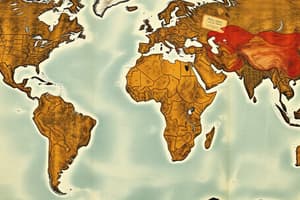Podcast
Questions and Answers
What is Pangaea?
What is Pangaea?
- A supercontinent that existed approximately 280 - 230 million years ago (correct)
- A large island surrounded by the Panthalassa ocean
- A current continent that covers one-third of the planet
- An underwater landmass formed during the late Paleozoic era
What was the result of the merging of modern-day continents into a large supercontinent?
What was the result of the merging of modern-day continents into a large supercontinent?
- Expansion of the Panthalassa ocean
- Creation of modern-day islands
- Formation of Pangaea (correct)
- Formation of separate continents
Who observed how Earth's continents appeared to fit together like a puzzle?
Who observed how Earth's continents appeared to fit together like a puzzle?
- Alfred Wegener (correct)
- Isaac Newton
- Marie Curie
- Charles Darwin
What did Alfred Wegener's theory of continental drift explain?
What did Alfred Wegener's theory of continental drift explain?
When did the supercontinent Pangaea start to break up?
When did the supercontinent Pangaea start to break up?
What caused the formation of Pangaea?
What caused the formation of Pangaea?
Approximately when did Laurasia and Gondwana split apart?
Approximately when did Laurasia and Gondwana split apart?
What was the sea that formed between Laurasia and Gondwana?
What was the sea that formed between Laurasia and Gondwana?
When did South America and Africa drift apart, creating the Atlantic Ocean?
When did South America and Africa drift apart, creating the Atlantic Ocean?
What is one evidence of Pangaea's existence mentioned in the text?
What is one evidence of Pangaea's existence mentioned in the text?
Flashcards are hidden until you start studying
Study Notes
- The continent of Pangaea, meaning "all the Earth," was broken up into two supercontinents: Laurasia and Gondwana.
- Laurasia consisted of North America and most of Europe, while Gondwana included South America, Africa, Antarctica, Australia, and Indo-Pakistan.
- The sea that formed between Laurasia and Gondwana was the Tethys Sea.
- Continental drift, a part of plate tectonics, was the cause of Pangaea's formation.
- The supercontinent existed approximately 280-230 million years ago.
- Pangaea began to break up around 200 million years ago due to seafloor spreading.
- Laurasia and Gondwana separated, forming the Tethys Sea in between.
- During the Jurassic period, Gondwana started to fracture and eventually split into Africa, Australia, South America, the Indian subcontinent, and the Arabian Peninsula.
- South America and Africa drifted apart around 140 million years ago, creating the Atlantic Ocean.
- Australia and Antarctica separated 45 million years ago, and Madagascar broke away from India and moved away from both.
- Laurasia split into North America, Europe, and Asia around 66-30 million years ago.
- The continents are still moving today, with some moving apart and others coming together.
- Evidence of Pangaea's existence includes fossil distribution, seemingly complementary coastlines, and rock strata patterns that match across continents.
Studying That Suits You
Use AI to generate personalized quizzes and flashcards to suit your learning preferences.




